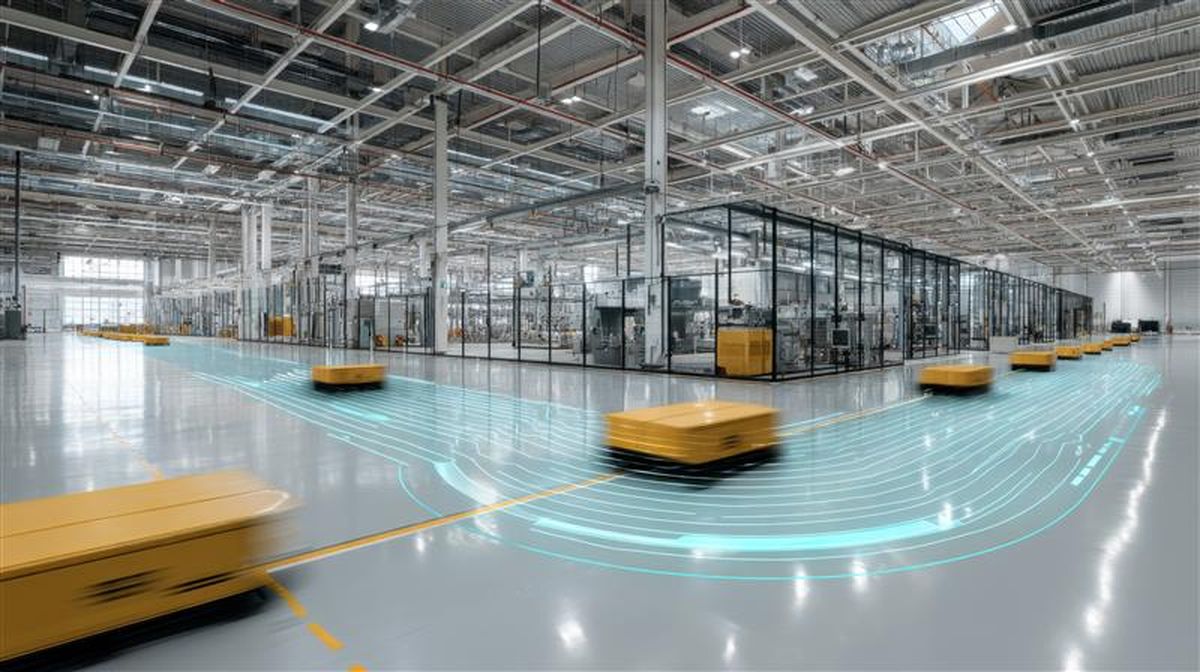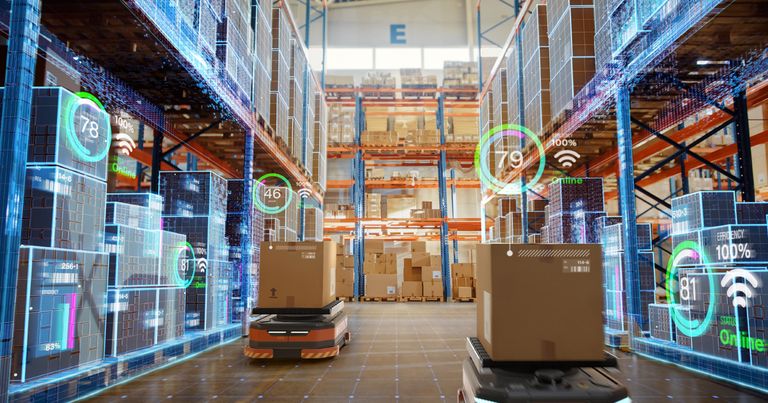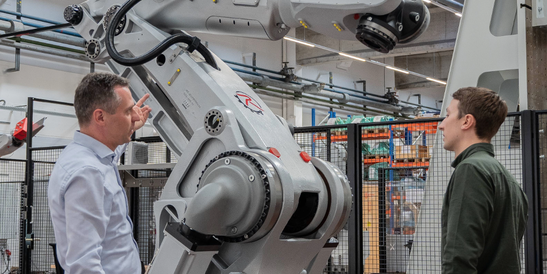The Role of Control Performance in the Development of Mobile Robots
- Robotics
- Intralogistics
- 29.7.2025
- Reading Time: {{readingTime}} min

Contents
When it comes to autonomous mobile robots (MR), control performance plays a key role in the design and successful operation of these systems, which navigate various environments independently. Depending on the company or industry, there are significant differences in performance requirements. These range from simple systems running on low-cost ARM-based devices (energy-efficient processors with minimal resource needs) to high-performance (and more expensive) platforms that require the latest generation of processors and more memory.
But why do mobile robots have such different control performance requirements, even though all systems pursue the same goal: moving something from A to B?
What Does Control Performance Mean in the Context of Mobile Robots?
The control performance of a mobile robot encompasses everything necessary for it to move efficiently and safely through its environment. This includes both the hardware (processors, sensors) and the software responsible for control and navigation. There are two basic approaches to implementing this control:
- Separate control units: In this approach, each function—such as navigation, communication, safety technology, and vehicle control—is handled by a separate control unit. These functions are optimized independently of one another.
- Combined control unit: A single control unit is used that integrates and optimizes all functions.
Control performance is therefore the sum of all functional requirements.
The specific performance needs also depend on the capabilities of the respective robot: Simple mobile robots used for sorting in e-commerce, for example, typically have fewer capabilities and thus lower control requirements. In contrast, a mobile robot with an integrated manipulator used in production requires significantly more functions, such as precise handling and assembly tasks, which leads to higher demands in terms of computing power, sensors, and control complexity.
Example A: Separate Control Units
In this case, a classic PLC (Programmable Logic Controller) is used for vehicle control, while a separate IPC (Industrial PC) handles navigation and communication. This architecture allows each function to be optimized independently, enabling specialized and thus efficient and independent processing.
This approach is often used when an independent navigation system is deployed. This standalone unit, including sensor integration, runs independently and is integrated into the vehicle. This allows both the navigation system and safety functions to be developed and maintained separately without interdependencies. This solution is especially beneficial in modular or retrofittable systems, providing maximum flexibility.
Example B: Integrated/Combined Control Unit
This approach combines control not just for partial functions. The architecture merges several tasks into a single control unit, reducing complexity and possibly lowering communication latency.
A typical application of this approach is found in mobile robots used in production environments or intralogistics, where a central control unit handles navigation, vehicle movement, safety technology, and sometimes even simple manipulation tasks. Integrating all functions into a shared control platform reduces hardware costs, saves space, and improves communication between software modules.
Such solutions are often used in autonomous transport applications—such as driverless transport systems or mobile robots without complex manipulators—where driving, positioning, obstacle detection, and simple manipulation tasks are consolidated in a compact control unit. This development is part of a broader trend: Mobile robots are increasingly revolutionizing logistics by automating transport, sorting, and handoff processes.
Why Do Control Performance Requirements Vary So Much?
The greatest variability in control performance stems primarily from two factors: navigation and sensor data processing. Depending on the application and environment, these functions demand different levels of computing power.
- Motion quality: Some applications require high movement precision, especially when vehicles need accurate positioning for handover or charging stations. These applications require more advanced navigation methods, which in turn require more computing power.
Environmental complexity: In simply structured environments such as warehouses with few obstacles, basic sensors and navigation techniques may suffice. In more dynamic environments, where people and manual transport vehicles can interfere with robot mobility, much more powerful systems are needed. Advanced sensors such as 3D laser scanners and camera systems are used here, requiring higher processing performance.
Speed: The robot’s movement speed also affects control performance. Fast MR applications—common in large logistics centers—require high computing power to ensure the robot can keep up with speed and dynamic demands.
Examples of Varying Control Performance Requirements
Example 1: Mobile Robots in E-Commerce Warehouses
- Environment: Clearly structured with few dynamic changes (e.g., warehouses or production lines).
- Motion quality: Increased requirements for positioning, especially at handover and charging stations.
- Speed: High speeds (up to 4 m/s) to ensure fast goods turnover.
In this case, simple sensors like 2D laser scanners and IMUs (Inertial Measurement Units) are sufficient. However, sensor data processing speed is critical to meet speed and precision requirements. Computing power must be able to process at least 50 measurements per second to determine vehicle position accurately and maintain high control quality.
Example 2: Mobile Robots for Pallet Transport
- Environment: Dynamic, with people and manual transport vehicles.
- Motion quality: Must detect obstacles and recognize pallet positions.
- Speed: Lower, due to mixed environments and unpredictable disruptions.
The robot must not only calculate its position but also detect and respond to obstacles. This requires advanced sensors like 3D laser scanners and cameras, along with powerful data processing. A data frequency of 20 Hz may be sufficient.
However, the sensor data volume is much greater. For example, a 3D laser scanner covering 360° horizontally and 40° vertically can capture up to 9,216,000 data points per second—a significant data volume that must be processed to ensure accurate navigation and obstacle detection.
(Source: https://www.robosense.ai/en/IncrementalComponents/RubyPlus)
Example 3: Highly Autonomous Mobile Robots Performing Additional Tasks
- Environment: Dynamic production setting with variable process steps.
- Motion quality: Must avoid obstacles and be precise during sorting and interaction.
- Speed: Medium to low, due to environment complexity and task duration.
Example task: While transporting goods, the robot sorts products by destination, labels them, and prepares them for the next process steps.
Such highly autonomous robots require expanded sensor arrays—multiple 3D laser scanners, camera systems, and sensor fusion. Additionally, they use Artificial Intelligence (AI) to make autonomous decisions, interpret environments, and respond to unforeseen situations. This requires significantly more computing power than the previous examples.
Impact of Control Performance on Computing Power
Sensor data processing and vehicle position calculation directly affect the required computing power. In a mobile robot using a platform strategy—a shared, scalable hardware and software base for different applications—developers must find a balanced architecture that enables efficient processing without overspending on resources for simpler robots. A strategic approach is crucial, especially in the in-house development of mobile robots.
Example calculation:
A simple robot with:
- Two laser scanners (2D): ~70,000 measurements/sec
- One IMU: ~5,000 data points/sec
- Two wheel encoders: ~2,000 odometry values/sec
Total: ~150,000 data points per second need to be arithmetically linked into a digital model, matched with a virtual map, and converted into appropriate movement actions.
More complex systems for object and obstacle detection include 3D laser scanners or cameras, leading to significantly more data that require powerful computing units.
- Intel RealSense D435 / D455 Depth resolution: 1280 x 720 pixels @ 90fps = 82,944,000 points per second per camera.
The data volume alone isn’t a reliable indicator of computing load, since processing methods play a larger role—but it does provide a useful benchmark.
A strategic approach is crucial, especially in the in-house development of mobile robots.
Conclusion: Control Performance as a Key Element in Mobile Robot Development
Control performance is a critical factor in developing mobile robots, as it directly affects the robot’s efficiency, precision, and flexibility. To ensure cost-effective development, companies must ensure that control performance matches the requirements of each application. This means defining environmental structure, speed, accuracy, and sensor processing needs in advance. Only then can the efficiency potential of mobile robots be fully realized. In a broader context—where mobile robots are used across various applications (e.g., logistics)—a modular and scalable platform strategy is crucial. Only with such a strategy can companies respond to varying demands and offer a wide range of vehicles with optimized control performance.









